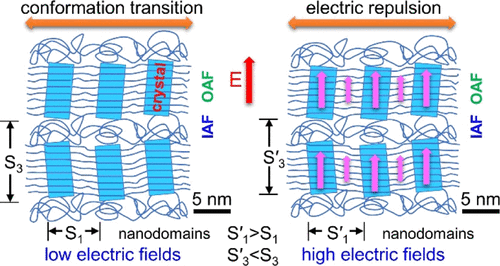当前位置:
X-MOL 学术
›
Macromolecules
›
论文详情
Our official English website, www.x-mol.net, welcomes your
feedback! (Note: you will need to create a separate account there.)
Origins of Electrostriction in Poly(vinylidene fluoride)-Based Ferroelectric Polymers
Macromolecules ( IF 5.1 ) Pub Date : 2020-12-03 , DOI: 10.1021/acs.macromol.0c02083 Thumawadee Wongwirat 1 , Zhiwen Zhu 2 , Guanchun Rui 3 , Ruipeng Li 4 , Pitak Laoratanakul 5 , Hezhi He 2 , Hathaikarn Manuspiya 1 , Lei Zhu 3
Macromolecules ( IF 5.1 ) Pub Date : 2020-12-03 , DOI: 10.1021/acs.macromol.0c02083 Thumawadee Wongwirat 1 , Zhiwen Zhu 2 , Guanchun Rui 3 , Ruipeng Li 4 , Pitak Laoratanakul 5 , Hezhi He 2 , Hathaikarn Manuspiya 1 , Lei Zhu 3
Affiliation

|
Although electrostriction is ubiquitous for dielectric polymers, giant electrostriction has not been observed until relaxor ferroelectric (RFE) poly(vinylidene fluoride) (PVDF)-based polymers are achieved. However, the exact origin for giant electrostriction in these polymers has not been fully understood. By studying the electrostriction in the uniaxially stretched films of a ferroelectric poly(VDF-co-trifluoroethylene) [P(VDF-TrFE)] random copolymer and an RFE poly(VDF-co-TrFE-co-chlorotrifluoroethylene) [P(VDF-TrFE-CTFE)] random terpolymer in this work, we confirmed that ferroelectric switching with large hysteresis, such as in the case of P(VDF-TrFE), was not genuine electrostriction. By decreasing large ferroelectric domains to the nanometer scale (i.e., 2–3 nm), such as in the case of the P(VDF-TrFE-CTFE) terpolymer, electrostriction with low hysteresis could be achieved. Two origins of the large electrostriction in these polymers were identified. The first was the mechano-electrostriction due to the poling field-induced conformation transformation of oriented polymer chains. The second was the electric repulsion of electrically aligned nanodomains. These effects could occur in both crystals and the oriented amorphous fraction, which links between the nanocrystals and the isotropic amorphous fraction. When the poling field was relatively low (e.g., <40 MV/m), the mechano-electrostriction was the major contribution and the electric repulsion effect was a minor contribution to electrostriction. Meanwhile, a strong temperature dependence of the low-field electrostriction coefficient was observed. Finally, we found an empirical inverse relationship between the electrostriction coefficient and the product of Young’s modulus and dielectric constant. The knowledge obtained from this study provides an insightful understanding of the electrostriction mechanism in PVDF-based electroactive polymers, which will find potential applications in sensors and actuators for wearable electronics and soft robotics.
中文翻译:

聚偏二氟乙烯系铁电聚合物中电致伸缩的起源
尽管电致伸缩普遍存在于介电聚合物中,但直到获得基于弛豫铁电(RFE)聚偏二氟乙烯(PVDF)的聚合物时,才观察到巨大的电致伸缩。但是,尚未完全理解这些聚合物中巨大电致伸缩的确切来源。通过研究铁电聚(VDF-共-三氟乙烯)[P(VDF-TrFE)]无规共聚物和RFE聚(VDF-共-TrFE-共)单轴拉伸薄膜中的电致伸缩-氯三氟乙烯)[P(VDF-TrFE-CTFE)]无规三元共聚物,我们证实了具有大滞后作用的铁电开关,例如P(VDF-TrFE),并不是真正的电致伸缩。通过将大铁电畴减小到纳米级(即2–3 nm),例如在P(VDF-TrFE-CTFE)三元共聚物的情况下,可以实现具有低滞后性的电致伸缩。确定了这些聚合物中大的电致伸缩的两个起源。首先是由于极化场诱导的取向聚合物链的构象转变而引起的机械电致伸缩。第二个是电排列的纳米域的电排斥。这些效应可能在晶体和取向的非晶态部分中发生,这在纳米晶体和各向同性非晶态部分之间存在联系。当极化场相对较低(例如,<40 MV / m)时,机械电致伸缩是主要的贡献,而电排斥效应对电致伸缩的贡献较小。同时,观察到低场电致伸缩系数的强烈温度依赖性。最后,我们发现电致伸缩系数与杨氏模量和介电常数的乘积之间存在经验反比关系。从这项研究中获得的知识提供了对基于PVDF的电活性聚合物中电致伸缩机理的深刻理解,它将在可穿戴电子设备和软机器人的传感器和执行器中找到潜在的应用。机械电致伸缩是主要的贡献,而电排斥效应对电致伸缩的贡献较小。同时,观察到低场电致伸缩系数的强烈温度依赖性。最后,我们发现电致伸缩系数与杨氏模量和介电常数的乘积之间存在经验反比关系。从这项研究中获得的知识提供了对基于PVDF的电活性聚合物中电致伸缩机理的深刻理解,它将在可穿戴电子设备和软机器人的传感器和执行器中找到潜在的应用。机械电致伸缩是主要的贡献,而电排斥效应对电致伸缩的贡献较小。同时,观察到低场电致伸缩系数的强烈温度依赖性。最后,我们发现电致伸缩系数与杨氏模量和介电常数的乘积之间存在经验反比关系。从这项研究中获得的知识提供了对基于PVDF的电活性聚合物中电致伸缩机理的深刻理解,它将在可穿戴电子设备和软机器人的传感器和执行器中找到潜在的应用。我们发现电致伸缩系数与杨氏模量和介电常数的乘积之间存在经验反比关系。从这项研究中获得的知识提供了对基于PVDF的电活性聚合物中电致伸缩机理的深刻理解,它将在可穿戴电子设备和软机器人的传感器和执行器中找到潜在的应用。我们发现电致伸缩系数与杨氏模量和介电常数的乘积之间存在经验反比关系。从这项研究中获得的知识提供了对基于PVDF的电活性聚合物中电致伸缩机理的深刻理解,它将在可穿戴电子设备和软机器人的传感器和执行器中找到潜在的应用。
更新日期:2020-12-22
中文翻译:

聚偏二氟乙烯系铁电聚合物中电致伸缩的起源
尽管电致伸缩普遍存在于介电聚合物中,但直到获得基于弛豫铁电(RFE)聚偏二氟乙烯(PVDF)的聚合物时,才观察到巨大的电致伸缩。但是,尚未完全理解这些聚合物中巨大电致伸缩的确切来源。通过研究铁电聚(VDF-共-三氟乙烯)[P(VDF-TrFE)]无规共聚物和RFE聚(VDF-共-TrFE-共)单轴拉伸薄膜中的电致伸缩-氯三氟乙烯)[P(VDF-TrFE-CTFE)]无规三元共聚物,我们证实了具有大滞后作用的铁电开关,例如P(VDF-TrFE),并不是真正的电致伸缩。通过将大铁电畴减小到纳米级(即2–3 nm),例如在P(VDF-TrFE-CTFE)三元共聚物的情况下,可以实现具有低滞后性的电致伸缩。确定了这些聚合物中大的电致伸缩的两个起源。首先是由于极化场诱导的取向聚合物链的构象转变而引起的机械电致伸缩。第二个是电排列的纳米域的电排斥。这些效应可能在晶体和取向的非晶态部分中发生,这在纳米晶体和各向同性非晶态部分之间存在联系。当极化场相对较低(例如,<40 MV / m)时,机械电致伸缩是主要的贡献,而电排斥效应对电致伸缩的贡献较小。同时,观察到低场电致伸缩系数的强烈温度依赖性。最后,我们发现电致伸缩系数与杨氏模量和介电常数的乘积之间存在经验反比关系。从这项研究中获得的知识提供了对基于PVDF的电活性聚合物中电致伸缩机理的深刻理解,它将在可穿戴电子设备和软机器人的传感器和执行器中找到潜在的应用。机械电致伸缩是主要的贡献,而电排斥效应对电致伸缩的贡献较小。同时,观察到低场电致伸缩系数的强烈温度依赖性。最后,我们发现电致伸缩系数与杨氏模量和介电常数的乘积之间存在经验反比关系。从这项研究中获得的知识提供了对基于PVDF的电活性聚合物中电致伸缩机理的深刻理解,它将在可穿戴电子设备和软机器人的传感器和执行器中找到潜在的应用。机械电致伸缩是主要的贡献,而电排斥效应对电致伸缩的贡献较小。同时,观察到低场电致伸缩系数的强烈温度依赖性。最后,我们发现电致伸缩系数与杨氏模量和介电常数的乘积之间存在经验反比关系。从这项研究中获得的知识提供了对基于PVDF的电活性聚合物中电致伸缩机理的深刻理解,它将在可穿戴电子设备和软机器人的传感器和执行器中找到潜在的应用。我们发现电致伸缩系数与杨氏模量和介电常数的乘积之间存在经验反比关系。从这项研究中获得的知识提供了对基于PVDF的电活性聚合物中电致伸缩机理的深刻理解,它将在可穿戴电子设备和软机器人的传感器和执行器中找到潜在的应用。我们发现电致伸缩系数与杨氏模量和介电常数的乘积之间存在经验反比关系。从这项研究中获得的知识提供了对基于PVDF的电活性聚合物中电致伸缩机理的深刻理解,它将在可穿戴电子设备和软机器人的传感器和执行器中找到潜在的应用。











































 京公网安备 11010802027423号
京公网安备 11010802027423号